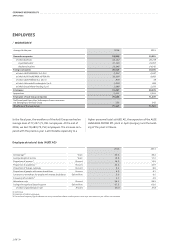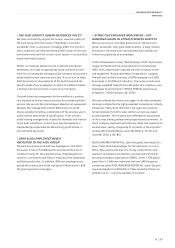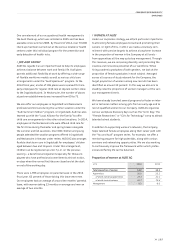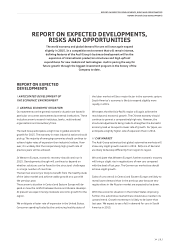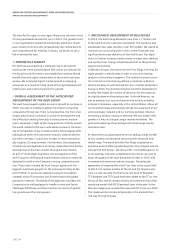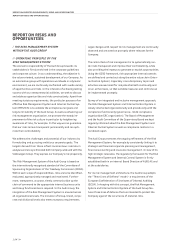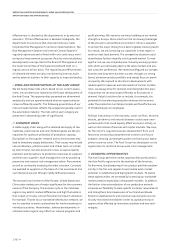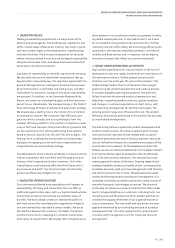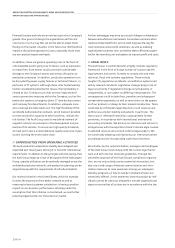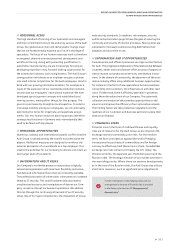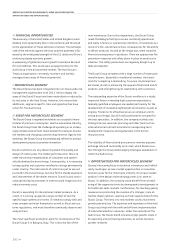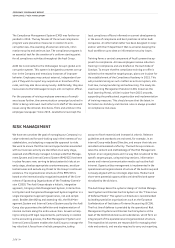Audi 2014 Annual Report Download - page 196
Download and view the complete annual report
Please find page 196 of the 2014 Audi annual report below. You can navigate through the pages in the report by either clicking on the pages listed below, or by using the keyword search tool below to find specific information within the annual report.
REPORT ON EXPECTED DEVELOPMENTS, RISKS AND OPPORTUNITIES
REPORT ON RISKS AND OPPORTUNITIES
196
>>
communication of all relevant information. The purpose of
these measures is to minimize or altogether avoid risks in the
preparation of the financial statements of AUDI AG and the
Consolidated Financial Statements as well as the Combined
Management Report of the Audi Group and AUDI AG (for
example, material errors in accounting or incorrect external
reporting).
The Audi Group accounting system is a fundamentally decen-
tralized organization. For the most part, the consolidated
companies handle accounting tasks independently. In individ-
ual instances, tasks are passed on to AUDI AG on the basis of
service agreements. The individual financial statements of
AUDI AG and the subsidiaries are prepared in accordance with
the applicable national legislation. The data is then trans-
ferred to the Consolidated Financial Statements in accordance
with IFRS. To ensure data security, data is transmitted to
Group Accounting at AUDI AG using a commercial encryption
product.
The IFRS accounting manual published by the Volkswagen
Group is observed, to achieve uniformity in the accounting
and measurement principles in accordance with the applica-
ble accounting standards. The Audi Group accounting guide-
line lays down further Group-wide rules on the scope of
reporting and the definition of the group of consolidated
companies for the Consolidated Financial Statements, as
well as the uniform application of statutory requirements.
Intra-Group business transactions are duly reflected by
means of proven instruments and processes such as exten-
sive rules on the reconciliation of balances between the
Group companies.
Controlling activities handled at Group level include in particular
the analysis and validation of the seperate financial statements
of our subsidiaries. The reports presented by the independent
auditors and the findings of the concluding discussions with
representatives of the individual companies are also taken into
account here. Systematic plausibility checks are run to some
extent automatically, but also conducted by experts. Complex
specific matters concerning the subsidiaries are regularly
coordinated in-year between the Consolidated Financial
Statements department and the subsidiary in question. The
“dual control principle” and the separation of functions are
likewise applied by way of key instruments of control in the
preparation of the financial statements by the Group compa-
nies. In addition, Group Auditing examines the regularity of
the financial reporting process for domestic and international
companies.
Financial reporting processes are mapped on the basis of the
Group-wide Volkswagen consolidation and corporate manage-
ment system (VoKUs). Furthermore, continuous information
sharing is maintained with Volkswagen Group Accounting.
VoKUs contains both historical data from Accounting and plan-
ning data from Controlling, and as such provides extensive
scope for consolidation and analysis. The system also offers
central master data management, a uniform reporting system,
an authorization concept and maximum flexibility to adapt to
changes in the legal framework. Data consistency is checked
with the aid of systematic, multi-stage validation functions,
such as completeness and content plausibility checks on the
Balance Sheet, Cash Flow Statement, Income Statement and
Notes.
//
RISK EARLY WARNING SYSTEM AND
MONITORING OF EFFECTIVENESS
Risk management is subject to wide-ranging statutory require-
ments. Section 91, Para. 2 of the German Stock Corporation
Act (AktG) governs the obligations of the Board of Management
concerning the early identification of risks that are a threat to
the Company as a going concern (supplemented by the German
Corporate Control and Transparency Act [KonTraG]). Section 107,
Para. 3 of the German Stock Corporation Act (supplemented by
the German Accounting Law Modernization Act [BilMoG])
obliges the Audit Committee of the Supervisory Board to mon-
itor the effectiveness of the Risk Management System (RMS)
and Internal Control System (ICS).
To meet these requirements, the Audi Group relies on an over-
arching systemic approach to risk identification, assessment
and documentation that takes account of the accompanying
risk management and control methods. Responsibility for the
organizational form of the Risk Management System and
Internal Control System rests with the Board of Management.
Hand in hand with the Group-wide systematized risk identifica-
tion process (governance, risk & compliance [GRC] process), an
overall picture of the risk situation is generated, while at the
same time the effectiveness of the control processes and over-
all system is assessed.


